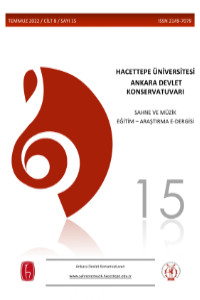Öz
In this study; the modal structure in the tenor part of a late thirteenth-century motet, which draws attention with its unique title Chose Loyset, was investigated. For this; the part’s melody was first transcribed into staff notation and then was subjected to a reductive analysis following the Schenkerian structural layers approach. Thus, the ordering and relations between the structural tones were revealed through a graphic notation and detailed explanations.
The analysis carried out revealed that the tenor melody, which is formulated as Ut (F): fa-ut, exhibits a stepwise fourth structural descent with the accompaniment of a binary movement consisting of G and F tones.
Due to the completion of the first phrase of the melody at the step just before the finalis, the possibility of an interrupted descent was discussed, and after examining both the Schenkerian understanding of interruption and the characteristics of the descent prior to so-called interruption, a negative opinion was expressed.
Moreover, by drawing attention to the “modal ambiguity” at the surface level, the dominating Protus plagalis sonority was found to be a result of the primary tone of the structural descent being expressed through a different modal type.
By analyzing Chose Loyset, which has interesting content despite its apparent simplicity, it was aimed to make an original contribution to the field of medieval music analysis which has scarce examples in the Turkish language, through a contemporary analytical approach.
Anahtar Kelimeler
Kaynakça
- Apel, W. (1949). The Notation of Polyphonic Music 900-1600. ABD: The Medieval Academy of America.
- Everist, M. (2007). Motets, French Tenors, and the Polyphonic Chanson ca. 1300. The Journal of Musicology, 24(3), s. 365-406.
- Guido d’Arezzo Micrologus. Erişim: 27.07.2022, https://chmtl.indiana.edu/tml/9th-11th/GUIMIC
- Judd, C. C. (1992). Modal Types and "Ut, Re, Mi" Tonalities: Tonal Coherence in Sacred Vocal Polyphony from about 1500, Journal of the American Musicological Society, 45(3), s. 428-467.
- McGee, T. J. (1990). Medieval Instrumental Dances [Kindle Edisyonu]. ABD: Indiana University Press.
- Page, C. (1993). Johannes de Grocheio on Secular Music: A Corrected Text and a New Translation. Plainsong and Medieval Music, 2(1), s. 17-41.
- Porterfield, R. (2014). Melodic Function and Modal Process in Gregorian Chant. [Doktora Tezi]. City University of New York, ABD.
- Schenker, H. (1979). Free Composition. (E. Oster, Çev.). New York: Longman Inc.
- Stakel, S. L., Relihan, J. C. (1985). The Montpellier Codex Part 4: Texts and Translations. H. Tischler (Ed.). ABD: A-R Editions.
- Turci-Escobar, J. (2007). Softening the Edges: Cadential Attenuation in Gesualdo's Six Books of Madrigals. Theory and Practice, 32, s. 101-135.
Öz
Bu çalışmada; bir geç on üçüncü yüzyıl motetinin, Chose Loyset biçimindeki özgün ibâresiyle dikkat çeken tenor partisinin ezgisindeki modal yapı araştırılmıştır. Bunun için; günümüz notasına aktarılan ezgi, Schenkerci yapısal katmanlar anlayışını benimseyen bir yaklaşımla indirgemeci bir analize tâbî tutulmuştur. Sunulan grafik notasyon ve eşliğindeki detaylı açıklamalar üzerinden eserdeki yapısal seslerin tertip ve ilişkileri ortaya konulmaya çalışılmıştır.
Gerçekleştirilen analizle, Ut (F): fa-ut biçiminde formülleştirilen ezginin yanaşık dörtlü bir yapısal iniş sergilediği tespit edilmiştir. Söz konusu inişe, G3 ve F3 perdelerinden ibâret iki terimli bir hareketin eşlik ettiği görülmüştür.
Ezginin ilk cümlesinin, finalisten hemen önceki adımda tamamlanmasına bağlı olarak kesintili bir iniş olasılığı tartışılmış, hem Schenkerci kesinti anlayışının hem de kesinti anına kadarki inişin irdelenmesi sonucunda aleyhte görüş bildirilmiştir.
Ayrıca yüzey seviyesindeki “modal muğlaklığa” dikkat çekilerek; baskın Protus plagalis sonoritesinin, yapısal inişin baş sesinin farklı bir modal tip dâhilinde ortaya konmasının bir sonucu olduğu saptanmıştır.
Görünüşteki yalınlığına karşın ilgi çekici bir içeriğe sahip olan Chose Loyset’in irdelenmesi ile güncel bir analitik yaklaşım üzerinden, anadilimizde son derece sınırlı örnekleri bulunan Orta Çağ müziği analizi alanına özgün bir katkı getirilmeye çalışılmıştır.
Anahtar Kelimeler
Kaynakça
- Apel, W. (1949). The Notation of Polyphonic Music 900-1600. ABD: The Medieval Academy of America.
- Everist, M. (2007). Motets, French Tenors, and the Polyphonic Chanson ca. 1300. The Journal of Musicology, 24(3), s. 365-406.
- Guido d’Arezzo Micrologus. Erişim: 27.07.2022, https://chmtl.indiana.edu/tml/9th-11th/GUIMIC
- Judd, C. C. (1992). Modal Types and "Ut, Re, Mi" Tonalities: Tonal Coherence in Sacred Vocal Polyphony from about 1500, Journal of the American Musicological Society, 45(3), s. 428-467.
- McGee, T. J. (1990). Medieval Instrumental Dances [Kindle Edisyonu]. ABD: Indiana University Press.
- Page, C. (1993). Johannes de Grocheio on Secular Music: A Corrected Text and a New Translation. Plainsong and Medieval Music, 2(1), s. 17-41.
- Porterfield, R. (2014). Melodic Function and Modal Process in Gregorian Chant. [Doktora Tezi]. City University of New York, ABD.
- Schenker, H. (1979). Free Composition. (E. Oster, Çev.). New York: Longman Inc.
- Stakel, S. L., Relihan, J. C. (1985). The Montpellier Codex Part 4: Texts and Translations. H. Tischler (Ed.). ABD: A-R Editions.
- Turci-Escobar, J. (2007). Softening the Edges: Cadential Attenuation in Gesualdo's Six Books of Madrigals. Theory and Practice, 32, s. 101-135.
Ayrıntılar
| Birincil Dil | Türkçe |
|---|---|
| Bölüm | Makaleler |
| Yazarlar | |
| Yayımlanma Tarihi | 30 Temmuz 2022 |
| Yayımlandığı Sayı | Yıl 2022 Cilt: 8 Sayı: 15 |


